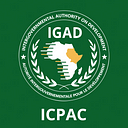Forecasting Water Availability for Effective Planning in the Horn of Africa Drylands
By Dr. Khalid Hassaballah
With contributions from the ICPAC Climate Change Technical Working Group.
The IGAD region is primarily defined by its arid, semi-arid nature. 70% of the region comprises arid and semi-arid lands (ASALs) that receive less than 600mm of annual rainfall. These areas are affected by recurrent droughts and are at risk of desertification and land degradation, further compounded by floods and other climate change occurrences.
Water security in the region is a significant challenge due to various factors, including climate change, population growth, poor governance, and inadequate infrastructure. Pollution from human activities such as agriculture, industry, and domestic waste disposal has affected water quality in most areas.
Climate change has contributed to irregular rainfall patterns, leading to an increased frequency of prolonged droughts and intense floods, which negatively affect water availability and quality. Furthermore, population growth increased the demand for water, exacerbating the issue of water scarcity. The region’s inadequate infrastructure has compounded this challenge, resulting in insufficient water distribution and storage. These conditions have been linked to diminished productivity, persistent food insecurity, extreme poverty, increased conflicts, and chronic vulnerability. These factors have disproportionately affected the pastoralist and agro-pastoralist communities that inhabit the region.
In Eastern Africa, hydrological forecasting is critical in managing water resources and mitigating the impacts of droughts and floods. This process involves predicting future water availability and distribution based on analysis of past and current weather and hydrological conditions.
The region’s reliance on rain-fed agriculture and the prevalence of ASALs make hydrological forecasting an essential tool for water management. Hydrological forecasts inform water management decisions, including water allocation, irrigation scheduling, and emergency response planning. By providing early warning of hydrological drought, hydrological forecasting can enable proactive measures to manage water resources effectively and minimize the impacts of extreme weather events, for example, through water rationing or groundwater recharge to help mitigate the impacts of the drought.
A hydrological drought is a type of drought that occurs when there is a prolonged period of below-normal water availability in a specific region or watershed. It is often the result of a combination of factors such as low precipitation, high evapotranspiration, and increased water use, leading to a depletion of water resources. Hydrological droughts can significantly impact agriculture, energy production, and the environment. They can lead to reduced crop yields, increased energy costs, and ecological damage, such as the drying up of wetlands and rivers.
The severity and duration of hydrological droughts vary depending on the location and the underlying causes. Their impacts can be long-lasting and far-reaching, affecting not only the affected region but also neighboring areas that rely on the same water resources.
It is essential to develop a regional hydrological model to anticipate the impacts of seasonal forecasts and climate projections on water scarcity and food insecurity across the Horn of Africa Drylands. While climate models forecast the probability of rain, hydrological models mimic the water cycle and forecast future water availability regarding surface water, soil moisture, and groundwater. These models use data from various sources, including precipitation, evapotranspiration, soil characteristics, and land topography.
Numerous factors, including weather patterns, climate change, land use and land cover changes, population increase, and water management techniques and practices, can impact the availability and accessibility of water. Decision-makers may anticipate and control some aspects using the information produced through hydrological forecasting, to ensure sustainable water usage, and reduce the effects of water scarcity or flooding.
ICPAC, through the Down2Earth(D2E) consortium, has developed a drylands-specific hydrological model (DRYP). The model output is presented as experimental layers on the East Africa Hazards Watch. The layers show the different components of the water balance for three sub-basins under the heading ‘Water Security’. The sub-basins are Ewaso Nyiro in Kenya, Edwayene in Somalia, and Awash in Ethiopia. The water forecasts include; soil moisture, potential groundwater recharge, water requirement satisfaction index (WRSI), actual evapotranspiration, and the number of days of extreme streamflow, as presented in Fig 1 below.
